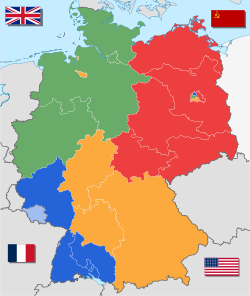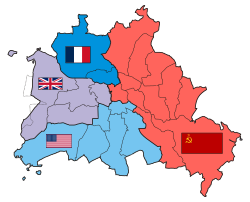
Back ألمانيا المحتلة من قبل قوات الحلفاء Arabic المانيا المحتله من قوات التحالف ARZ Ocupación aliada d'Alemaña AST 1945–1949-cu illərdə Almaniya Azerbaijani ایشغال آلمانی AZB Окупирана от Съюзниците Германия Bulgarian Zones d'ocupació aliada a Alemanya Catalan Okupační zóny Německa Czech Besættelseszoner i Tyskland efter 2. verdenskrig Danish Deutschland 1945 bis 1949 German
Allied-Administered Germany Allied Occupation Zones in Germany | |||||||||||||
|---|---|---|---|---|---|---|---|---|---|---|---|---|---|
| 1945 — 1949 | |||||||||||||
 Occupation zones in Germany (1945) | |||||||||||||
| Status | Military occupation | ||||||||||||
| Capital | Berlin (de jure) | ||||||||||||
| Governors (1945) | |||||||||||||
• UK zone | Field Marshal Montgomery | ||||||||||||
• French zone | General Lattre de Tassigny | ||||||||||||
• US zone | General Eisenhower | ||||||||||||
• Soviet zone | Marshal Zhukov | ||||||||||||
| Historical era | Cold War | ||||||||||||
| May 8, 1945 | |||||||||||||
| July 5, 1945 1945 | |||||||||||||
• Saar protectorate | December 15, 1947 | ||||||||||||
| 23 May, 1949 | |||||||||||||
| 7 October, 1949 1949 | |||||||||||||
| September 12, 1990 | |||||||||||||
| ISO 3166 code | DE | ||||||||||||
| |||||||||||||
¹ German reunification took place on October 3, 1990.  | |||||||||||||
After World War II Nazi Germany west of the Oder-Neisse line was divided into four occupation zones. This had been agreed in London in September 1944.
They were occupied by the allied powers who defeated Germany (the Soviet Union, the United Kingdom and the United States) and by France. This was done for administrative purposes during the period 1945-1949.
In the closing weeks of fighting in Europe the American forces had actually pushed beyond the previously agreed upon occupation zone boundaries, sometimes by as much as 200 miles. After about two months of holding certain areas meant to be in the Soviet zone, the American forces withdrew during July 1945.
